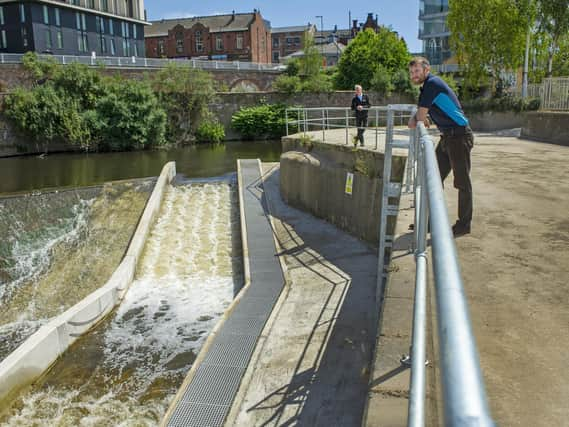Salmon can return to the River Don for the first time since the Industrial Revolution thanks to new fish passes


For more than 200 years, the river, which runs through the heart of South Yorkshire, has been broken up by the weirs created to ensure a steady stream of water to the mills which were at the heart of the industrial age.
But a collaboration between conservation and waterways organisations has seen the river reconnected with the hope salmon will once again make their way to spawning grounds along the River Don.
Advertisement
Hide AdAdvertisement
Hide AdThe final piece of the 20-year project carried out by the Don Catchment Rivers Trust, Environment Agency, Canal and River Trust and Yorkshire Water was put in place last summer when the fish pass at Masbrough in Rotherham was completed.
Ben Gillespie, lead environmental adviser for Yorkshire Water, said the project had been a “fantastic turnaround” for a river which was at one time declared ecologically dead.
“It used to be yellow and blue due to the industrial work going on in the area and while the industrialisation of the river and the mills brought brilliant benefits for industry, it was at a massive cost to the river.
“Salmon along with every other fish species disappeared.”
With national legislation brought in to control what was being released back into our waterways, Ben said water quality really improved and gradually they saw fish return.
Advertisement
Hide AdAdvertisement
Hide Ad“The River Don starts in the Peak District and we knew some populations had survived upstream.
“The Environment Agency was doing some work in the 80s and an angler accidentally caught a salmon quite far down the River Don. So we knew salmon could be trying to return but the fragmentation was a barrier to that.
“The river passes through very urban spaces and there were at least 20 major structures stopping fish from getting around the river and successfully living out their life cycle."
Dr Ed Shaw, director of the Don Catchment Rivers Trust, said fragmentation of the river was damaging to all species including the European eel and coarse fish populations.
Advertisement
Hide AdAdvertisement
Hide Ad“Returning salmon to the River Don was a key project for the trust but our aim was to also improve the ecological environment of the Don catchment and get communities involved.
"The River Don has been a part of people’s lives for centuries. In the distant past it was a way for people to get about as well as a major source of food. In Sheffield people used to eat salmon caught in the river.”
Dr Shaw said they had all been delighted when the pass at Masbrough was finished.
“It has made such a difference ecologically and we didn’t think we would see the benefits so quickly.”
Advertisement
Hide AdAdvertisement
Hide AdHe added that there were signs the salmon were returning with one member of the trust catching sight of what they thought could be three fish in December last year.
Mr Gillespie described the completion of the pass at Rotherham, which is owned by the Canal and Rivers Trust, as a “big crescendo moment”.
“To know that river life now has free rein from Sheffield to the sea and back up again is a really nice moment to be able to step back and reflect on."
Jonathan Hart-Woods, senior ecologist at the Canal and Rivers Trust, said working in collaboration had helped make the project a success.
Advertisement
Hide AdAdvertisement
Hide Ad“Building partnerships really helped as we are able to share expertise and resources, making us much stronger.
“When we started, fish passes were a relatively new thing and getting the first one built was a challenge but once it was done we were all able to see the benefits.
Anthony Downing, Environment Agency catchment co-ordinator for the Don and Rother, agreed, calling the re-opened route a “great milestone”.
“Through great partnership working across a number of organisations all the weirs and obstacles between Doncaster and Sheffield are now passable to salmon and other fish species.
Advertisement
Hide AdAdvertisement
Hide Ad“This has improved biodiversity and the ecological health of the whole river.”
Mr Downing also said there had been encouraging signs of the fish returning.
“Over the past couple of years there has been growing evidence of salmon making their way up the River Don during the October to January migration season and we’re confident they can now reach spawning areas to breed in the Don.”
The decision was made to allow the natural re-population of the river rather than introducing fish by re-stocking.
“We wanted to rebuild stocks organically,” said Dr Shaw.
Advertisement
Hide AdAdvertisement
Hide Ad“We are aware that stocking has been tried elsewhere but it hasn’t always been effective and sometimes it has been counter productive.”
Mr Gillespie agreed saying each river population had its own genetics and if it were possible to colonise naturally it would be better for the fish and the river.
There are plans to build on the success of the River Don project by opening up more spawning habitats upstream of Sheffield and also on the Dearne and Rother.
Dr Shaw said they were looking at putting fish passes in the Upper Don and other tributaries to open up habitats for other species in the catchment as well as salmon.
Advertisement
Hide AdAdvertisement
Hide AdMr Downing said the aim was to re-establish salmon across the whole river catchment.
All the organisations involved said getting communities involved was a key part to maintaining the success of the project.
Mr Hart-Woods said: “We have changed the emphasis on how we engage people around the river.
“And we now have salmon trails which is a great way of helping establish that interest.”
Comment Guidelines
National World encourages reader discussion on our stories. User feedback, insights and back-and-forth exchanges add a rich layer of context to reporting. Please review our Community Guidelines before commenting.